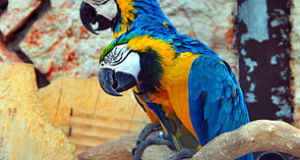Also known as Chlamydiosis, Chlamydophilosis and Psittacosis, Chlamydia infection presents little danger to most bird owners, but is a real concern for others. Today we’ll take a look at this much-discussed and often misunderstood condition.
Infection and Immunity
Many parrots, most pigeons and certain other birds (chickens) carry the single-celled bacterium that causes Psittacosis yet remain in good health.
Known as Chlamydophila psittaci, this micro-organism may not even show up in routine fecal tests, despite being present in the bird. Chlamydophila psittaci is present in many commercial aviaries…chicks are infected by their parents. Typically, infected chicks quickly develop an immune response that battles the bacterium, and by age 6 – 12 months are largely immune to the particular strain of C. psittaci to which they were exposed.
How Birds Become Ill
Problems arise when these young birds enter the pet trade – shipment to pet stores, overcrowding, a noisy environment filled with people and similar situations cause the birds a great deal of stress. This stress weakens the immune system and the bacteria already present in the bird are then able to multiply and cause a serious infection.
Illness can also occur when birds from different breeders are mixed together at pet stores or in one’s home. The immunity that birds acquire when exposed to low levels of C. psittaci (in the aviary in which they were hatched) is usually effective only against 1 particular strain of the bacteria. When mixed with birds carrying other strains of C. psittaci, they become ill.
Symptoms/Diagnosis of Chlamydia Infection
Birds rendered ill by exposure to C. psittaci usually develop a respiratory infection. Their inflamed sinus cavities leak fluids, which eventually ooze out of the nares (nostrils). These fluids dampen and mat the feathers around the upper bill and cause the bird to sneeze. In severe cases, the nostrils become blocked, leaving the bird to “pant” with its bill open in an attempt to breathe. Red, irritated eyes, puffed up feathers and a lethargic demeanor (please see photo of Heron) are also typically seen in birds suffering from respiratory infections.
The liver and other internal organs, air sacs and genitals may also be colonized by bacteria in time. Birds that recover may suffer reproductive problems if their genitals had been involved in the infection.
Chlamydia infection may be diagnosed by laboratory examination of the stool, fluids leaking from the nares, blood or affected tissues. Treatment with Doxycycline is often effective.
People at Risk
The immune systems of most healthy adults prevent C. psittaci from causing any ill effects.
However, immunocompromised people (those with immune systems weakened by HIV or other conditions), the elderly, and infants are at serious risk. It is strongly suggested that you speak with your personal physician before acquiring a parrot or other bird if you or anyone in your household could be seriously affected by exposure to C. psittaci. Remember, the bird does not need to be ill in order to infect a person – immune birds, as described above, will appear to be in perfect health.
Further Reading
You can read about other Zoonotic Diseases (those that can be passed from animals to people) on the website of the Arizona Exotic Animal Hospital.
 That Bird Blog – Bird Care and History for Pet Birds
That Bird Blog – Bird Care and History for Pet Birds



